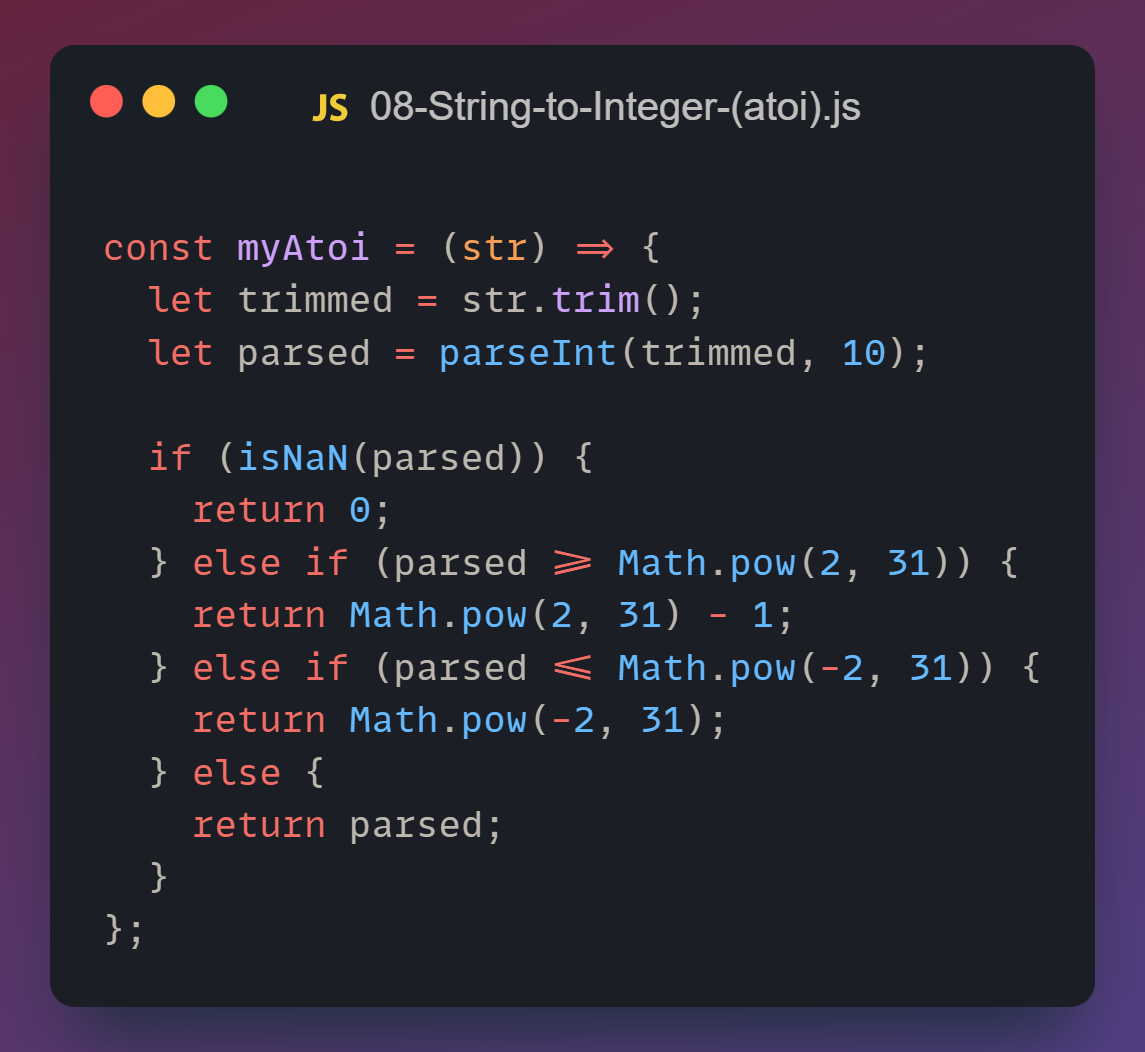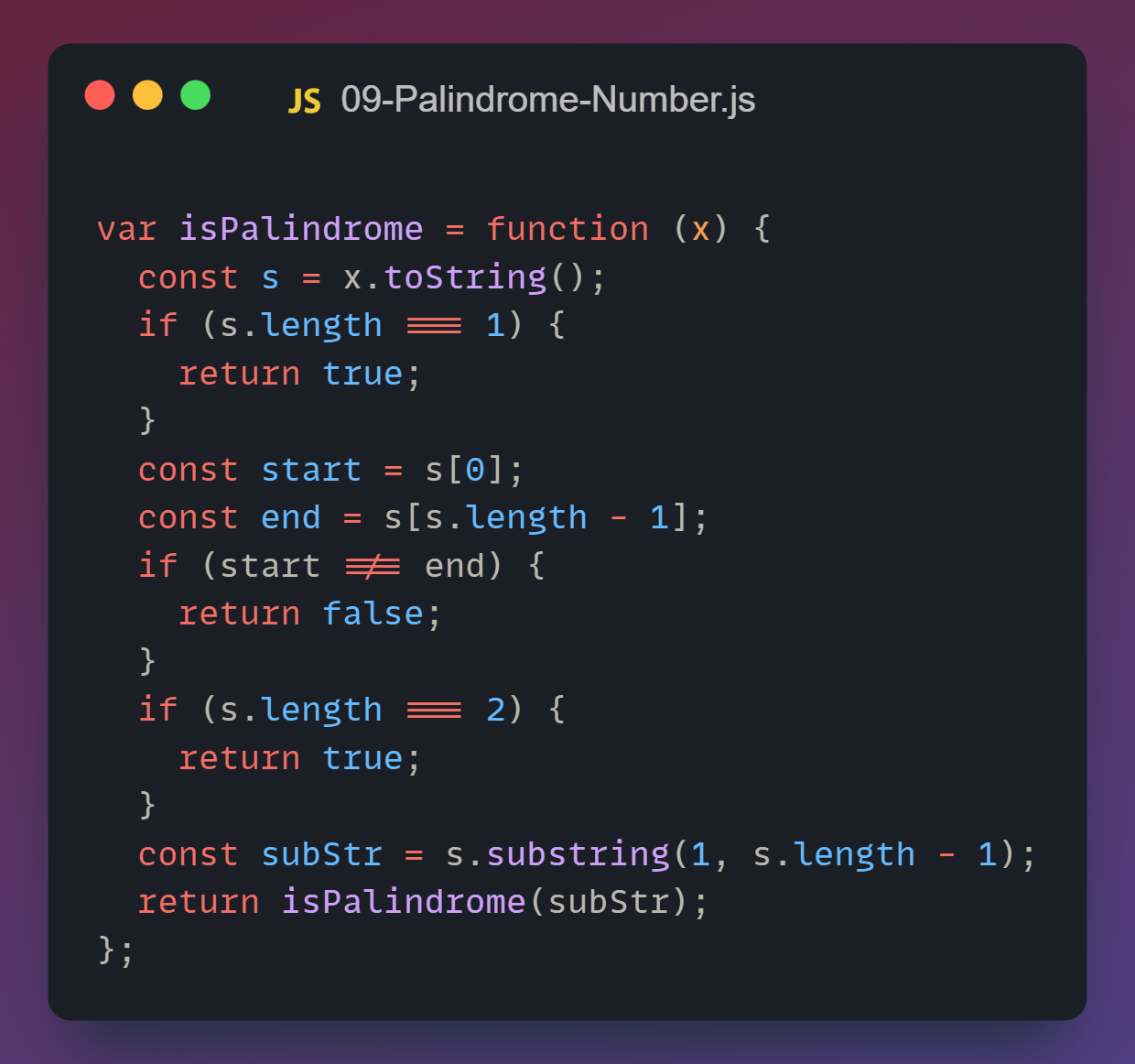Javascript in Leetcode 07–09 | 面試問題

可以來此找原始碼 | my github
7. Reverse Integer
Given a signed 32-bit integer x, return x with its digits reversed. If reversing x causes the value to go outside the signed 32-bit integer range [-231, 231 - 1], then return 0.
Assume the environment does not allow you to store 64-bit integers (signed or unsigned).
Example 1:
Input: x = 123 Output: 321
Example 2:
Input: x = -123 Output: -321
Example 3:
Input: x = 120 Output: 21
Constraints:
-231 <= x <= 231 - 1

8. String to Integer (atoi)
Implement the myAtoi(string s) function, which converts a string to a 32-bit signed integer (similar to C/C++'s atoi function).
The algorithm for myAtoi(string s) is as follows:
- Read in and ignore any leading whitespace.
- Check if the next character (if not already at the end of the string) is
'-'or'+'. Read this character in if it is either. This determines if the final result is negative or positive respectively. Assume the result is positive if neither is present. - Read in next the characters until the next non-digit character or the end of the input is reached. The rest of the string is ignored.
- Convert these digits into an integer (i.e.
"123" -> 123,"0032" -> 32). If no digits were read, then the integer is0. Change the sign as necessary (from step 2). - If the integer is out of the 32-bit signed integer range
[-231, 231 - 1], then clamp the integer so that it remains in the range. Specifically, integers less than-231should be clamped to-231, and integers greater than231 - 1should be clamped to231 - 1. - Return the integer as the final result.
Note:
- Only the space character
' 'is considered a whitespace character. - Do not ignore any characters other than the leading whitespace or the rest of the string after the digits.
Example 1:
Input: s = "42"
Output: 42
Explanation: The underlined characters are what is read in, the caret is the current reader position.
Step 1: "42" (no characters read because there is no leading whitespace)
^
Step 2: "42" (no characters read because there is neither a '-' nor '+')
^
Step 3: "42" ("42" is read in)
^
The parsed integer is 42.
Since 42 is in the range [-231, 231 - 1], the final result is 42.
Example 2:
Input: s = " -42"
Output: -42
Explanation:
Step 1: " -42" (leading whitespace is read and ignored)
^
Step 2: " -42" ('-' is read, so the result should be negative)
^
Step 3: " -42" ("42" is read in)
^
The parsed integer is -42.
Since -42 is in the range [-231, 231 - 1], the final result is -42.
Example 3:
Input: s = "4193 with words"
Output: 4193
Explanation:
Step 1: "4193 with words" (no characters read because there is no leading whitespace)
^
Step 2: "4193 with words" (no characters read because there is neither a '-' nor '+')
^
Step 3: "4193 with words" ("4193" is read in; reading stops because the next character is a non-digit)
^
The parsed integer is 4193.
Since 4193 is in the range [-231, 231 - 1], the final result is 4193.
Constraints:
0 <= s.length <= 200sconsists of English letters (lower-case and upper-case), digits (0-9),' ','+','-', and'.'.

9. Palindrome Number
Given an integer x, return true if x is palindrome integer.
An integer is a palindrome when it reads the same backward as forward.
- For example,
121is a palindrome while123is not.
Example 1:
Input: x = 121 Output: true Explanation: 121 reads as 121 from left to right and from right to left.
Example 2:
Input: x = -121 Output: false Explanation: From left to right, it reads -121. From right to left, it becomes 121-. Therefore it is not a palindrome.
Example 3:
Input: x = 10 Output: false Explanation: Reads 01 from right to left. Therefore it is not a palindrome.
Constraints:
-231 <= x <= 231 - 1
Follow up: Could you solve it without converting the integer to a string?

